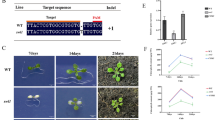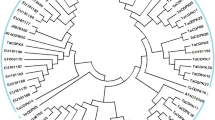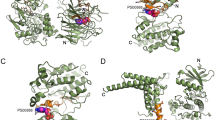Abstract
The marine red alga Pyropia tenera (Rhodophyta) is one of the most valuable and widely cultivated Pyropia species. Temperature is a major factor that affects the growth and life cycle of Pyropia. Small heat-shock proteins (sHSPs) play a crucial role in heat stress response. Among sHSPs isolated from P. tenera, PtsHSP19.6 showed the strongest response to heat stress but not to other abiotic stresses such as desiccation and freezing. Although an α-crystallin domain was found in PtsHSP19.6, its amino acid sequence showed low homology with known sHSPs, except those from red algae. This led us to investigate whether PtsHSP19.6 from red algae has chaperone activity and is involved in high-temperature tolerance. PtsHSP19.6 significantly reduced the thermal aggregation of alcohol dehydrogenase used as a substrate. When PtsHSP19.6 was introduced into Escherichia coli, the transformed cells grew better than the control cells under high-temperature conditions. Fluorescence of the PtsHSP19.6-GFP fusion protein was detected from granules in the cytoplasm. The in vitro analysis data showed that PtsHSP19.6 forms oligomers with a molecular weight greater than 240 kDa in solution. This study showed that PtsHSP19.6 from P. tenera forms oligomers in solution and plays a role in heat tolerance, with a chaperone function similar to that observed in green plants.






Similar content being viewed by others
References
Basha E, O’Neill H, Vierling E (2012) Small heat shock proteins and alpha-crystallins: dynamic proteins with flexible functions. Trends Biochem Sci 37:106–117
Blouin NA, Brodie JA, Grossman AC, Xu P, Brawley SH (2011) Porphyra: a marine crop shaped by stress. Trends Plant Sci 16:29–37
Choi S, Hwang MS, Im SO, Kim NJ, Jeong WJ, Park EJ, Gong YG, Choi DW (2013) Transcriptome sequencing and comparative analysis of the gametophyte of Pyropia tenera under normal and high-temperature condition. J Appl Phycol 25:1237–1246
Finn TE, Nunez AC, Sunde M, Easterbrook-Smith SB (2012) Serum albumin prevents protein aggregation and amyloid formation and retains chaperone-like activity in the presence of physiological ligands. J Biol Chem 287:21530–21540
Hwang MS, Chung IK, Oh YS (1997) Temperature responses of Porphyra tenera Kjellman and P. yezoensis Ueda (Bangiales, Rhodophyta) from Korea. Algae 12:207–213
Hwang MS, Kim SM, Ha DS, Baek JM, Kim HS, Choi HG (2005) DNA sequences and identification of Porphyra cultivated by natural seeding on the southwest coast of Korea. Algae 20:183–196
Im S, Choi S, Hwang MS, Park EJ, Jeong WJ, Choi DW (2015) De novo assembly of transcriptome from the gametophyte of the marine red algae Pyropia seriata and identification of abiotic stress response genes. J Appl Phycol 27:1343–1353
Jin Y, Yang S, Im S, Jeong WJ, Park EJ, Choi DW (2017) Overexpression of the small heat shock protein, PtsHSP19.3 from marine red algae, Pyropia tenera (Bangiales, Rhodophyta) enhances abiotic stress tolerance in Chlamydomonas. J Plant Biotech 44:287–295
Kedersha NL, Gupta M, Li W, Miller I, Anderson P (1999) RNA-binding proteins TIA-1 and TIAR link the phosphorylation of EIF-2α to the assembly of mammalian stress granules. J Cell Biol 147:1431–1442
Kim KK, Kim R, Kim SH (1998) Crystal structure of a small heat shock protein. Nature 394:595–599
Kirschner M, Winkelhaus S, Thierfelder JM, Nover L (2000) Transient expression and heat-stress-induced co-aggregation of endogenous and heterologous small heat-stress proteins in tobacco protoplasts. Plant J 24:397–411
Kobayashi Y, Harada N, Nishimura Y, Saito T, Nakamura M, Fujiwara T, Kuroiwa T, Misumi O (2014) Algae sense exact temperatures: small heat shock proteins are expressed at the survival threshold temperature in Cyanidioschyzon merolae and Chlamydomonas reinhardtii. Genome Biol Evol 7:2731–2740
Kotak S, Vierling E, Baumlein H, von Koskull-Doring P (2007) A novel transcriptional cascade regulating expression of heat stress proteins during seed development of Arabidopsis. Plant Cell 19:182–195
Lambert W, Koeck PJ, Ahrman E, Purhonen P, Cheng K, Elmlund D, Hebert H, Emanuelsson C (2011) Subunit arrangement in the dodecameric chloroplast small heat shock protein Hsp21. Protein Sci 20:291–301
Lee BH, Won SH, Lee HS, Miyao M, Chung WI, Kim IJ, Jo JK (2000) Expression of the chloroplast-localized small heat shock protein by oxidative stress in rice. Gene 245:283–290
Luo QJ, Zhu ZG, Zhu ZJ, Yang R, Qian FJ, Chen HM, Yan XJ (2014) Different responses to heat shock stress revealed heteromorphic adaptation strategy of Pyropia haitanensis (Bangiales, Rhodophyta). PLoS One 9:e94354
Malik MK, Slovin JP, Hwang CH, Zimmerman JL (1999) Modified expression of a carrot small heat shock protein gene, hsp17.7, results in increased or decreased thermotolerance double danger. Plant J 20:89–99
McLachlan J (1973) Growth media-marine. In: Stein JR (ed) Handbook of phycological methods. Cambridge University Press, New York
Moon JH, Lee HJ, Park SY, Song JM, Park MY, Park HM, Sun J, Park JH, Kim BY, Kim JS (2011) Structures of iron-dependent alcohol dehydrogenase 2 from Zymomonas mobilis ZM4 with and without NAD+ cofactor. J Mol Biol 407:413–424
Mu C, Zhang S, Yu G, Chen N, Li X, Liu H (2013) Overexpression of small heat shock protein LimHSP16.45 in Arabidopsis enhances tolerance to abiotic stresses. PLoS One 8:e82264
Na YJ, Lee HN, Wi JW, Jeong WJ, Choi DW (2018) PtDRG1, a desiccation response gene from Pyropia tenera (Rhodophyta), exhibits chaperone function and enhances abiotic stress tolerance. Mar Biotechnol 50:584–593
Neta-Sharir I, Isaacson T, Lurie S, Weiss D (2005) Dual role for tomato heat shock protein 21: protecting photosystem II from oxidative stress and promoting color changes during fruit maturation. Plant Cell 17:1829–1838
Ruibal C, Castro A, Carballo V, Szabados L, Vidal S (2013) Recovery from heat, salt and osmotic stress in Physcomitrella patens requires a functional small heat shock protein PpHsp16.4. BMC Plant Biol 13:174
Sahoo D, Tang X, Yarish C (2002) Porphyra-the economic seaweed as a new experimental system. Curr Sci 83:1313–1316
Scharf KD, Siddique M, Vierling E (2001) The expanding family of Arabidopsis thaliana small heat stress proteins and a new family of proteins containing alpha-crystallin domains Acd proteins. Cell Stress Chaperones 6:225–237
Siddique M, Gernhard S, von Koskull-Doring P, Vierling E, Scharf KD (2008) The plant sHSP superfamily: five new members in Arabidopsis thaliana with unexpected properties. Cell Stress Chaperones 13:183–117
Soto A, Allona I, Collada C, Guevara MA, Casado R, Rodriguez-Cerezo E, Aragoncillo C, Gomez L (1999) Heterologous expression of a plant small heat-shock protein enhances Escherichia coli viability under heat and cold stress. Plant Physiol 120:521–528
Sun W, Bernard C, van de Cotte B, van Montagu M, Verbruggen N (2001) At-HSP17.6A, encoding a small heat-shock protein in Arabidopsis, can enhance osmotolerance upon overexpression. Plant J 27:407–415
Sun W, Montagu V, Verbruggen N (2002) Small heat shock proteins and stress tolerance in plants. Biochem Biophys Acta 1577:1–9
van Montfort R, Slingsby C, Vierling E (2002) Structure and function of the small heat shock protein/alpha-crystallin family of molecular chaperones. Adv Protein Chem 59:105–156
van Montfort RL, Basha E, Friedrich KL, Slingsby C, Vierling E (2001) Crystal structure and assembly of a eukaryotic small heat shock protein. Nature Struct Biol 8:1025–1030
Volkov RA, Panchuk II, Schoffl F (2005) Small heat shock proteins are differentially regulated during pollen development and following heat stress in tobacco. Plant Mol Biol 57:487–450
Wang W, Vinocur B, Shoseyov O, Altman A (2004) Role of plant heat-shock proteins and molecular chaperons in the abiotic stress response. Trends Plant Sci 9:244–252
Waters ER (2013) The evolution, function, structure, and expression of the plant sHSPs. J Exp Bot 64:391–403
Waters ER, Aevermann BD, Sanders-Reed Z (2008) Comparative analysis of the small heat shock proteins in three angiosperm genomes identifies new subfamilies and reveals diverse evolutionary patterns. Cell Stress Chaperones 13:127–142
Waters ER, Rioflorido I (2007) Evolutionary analysis of the small heat shock proteins in five complete algal genomes. J Mol Evol 65:162–174
Wehmeyer N, Vierling E (2000) The expression of small heat shock proteins in seeds responds to discrete developmental signals and suggests a general protective role in desiccation tolerance. Plant Physiol 122:1099–1108
Weber C, Nover L, Fauth M (2008) Plant stress granules and mRNA processing bodies are distinct from heat stress granules. Plant J 56:517–530
Yan H, Zhang A, Chen J, He X, Xu B, Xie G, Miao Z, Zhang X, Huang L (2017) Geneome-wide analysis of the PvHsp20 family in switchgrass: motif, genomic organization, and identification of stress or developmental-related Hsp20s. Front Plant Sci 8:1024
Yoo SD, Cho YH, Sheen J (2007) Arabidopsis mesophyll protoplasts: a versatile cell system for transient gene expression analysis. Nat Protoc 2:1565–1572
Zhai M, Sun Y, Jia C, Peng S, Liu Z, Yang G (2016) Over-expression of JrsHSP17.3 gene from Juglans regia confer the tolerance to abnormal temperature and NaCl stresses. J Plant Biol 59:549–558
Zhang K, Ezemaduka AN, Wang Z, Hu H, Shi X, Liu C, Lu X, Fu X, Chang Z, Yin CC (2015) A novel mechanism for small heat shock proteins to function as molecular chaperones. Sci Rep 5:8811
Acknowledgments
We thank Professor Sang Bong Choi at Myongji University for providing the stress granule and processing body marker-RFP gene constructs, RBP47-RFP and DCP5-RFP.
Funding
This study was financially supported by the Golden Seed Project funded by the Ministry of Oceans and Fisheries (MOF) (grant number 213008-05-2-SB830) and Chonnam National University (grant number 2017-2657).
Author information
Authors and Affiliations
Corresponding author
Additional information
Publisher’s Note
Springer Nature remains neutral with regard to jurisdictional claims in published maps and institutional affiliations.
Electronic supplementary material
Supplementary Table 1
(PPTX 46 kb)
Rights and permissions
About this article
Cite this article
Yang, S., Na, Y., Im, S. et al. PtsHSP19.6, a small heat-shock protein from the marine red alga Pyropia tenera (Rhodophyta), aggregates into granules and enhances heat tolerance. J Appl Phycol 31, 1921–1929 (2019). https://doi.org/10.1007/s10811-018-1728-3
Received:
Revised:
Accepted:
Published:
Issue Date:
DOI: https://doi.org/10.1007/s10811-018-1728-3




